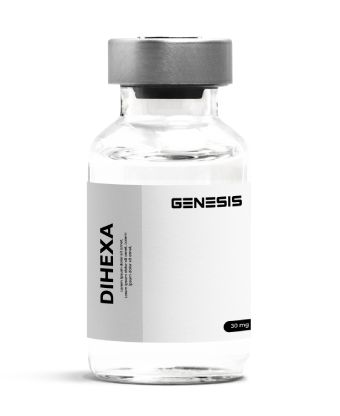Semaglutide injection is used to treat type 2 diabetes. It is used together with diet and exercise to help control your blood sugar. This medicine is also used to lower the risk of heart attack, stroke, or death in patients with type 2 diabetes and heart or blood vessel disease.
$59.50
Treats Alzheimer’s disease [1-8]
Combats Parkinson’s disease [9-14]
Improves learning and memory retention [15-25]
Improves stroke recovery [26-29]
Accelerates recovery from spinal cord injury and nerve damage [30-34]
Protects against hearing loss [35]
Dihexa Peptide is a peptide variant derived from angiotensin IV, a naturally occurring peptide in the body. Dihexa has gained attention for its potential to enhance neurotrophic activity, which is crucial for the growth and maintenance of nerve cells in the brain.
Dihexa, also known as N-hexanoic-Tyr-Ile-(6) aminohexanoic amide, is a synthetic peptide that was developed for potential therapeutic applications. It was originally designed as a small molecule compound with neuroregenerative properties.
Dihexa has been studied for its ability to enhance certain cognitive function in animal models of dementia, and promote neuronal growth and synaptic connectivity. It has shown potential in preclinical studies for the treatment of neurodegenerative diseases and neurological diseases such as dementia as Alzheimer’s disease, by improving memory and other certain cognitive functions and abilities.
The mechanism of action of Dihexa involves its binding to hepatocyte growth factor (HGF) receptor, also known as c-Met. This binding activates downstream signaling pathways that promote neuronal survival, neurogenesis, and synaptogenesis.
It’s important to note that while Dihexa has shown promise in preclinical studies, its safety and efficacy in humans have not been extensively studied. Further research is needed to fully understand its potential therapeutic applications and any associated risks.
Dihexa is a synthetic peptide that has been studied for its potential neuroregenerative effects. Its mechanism of action involves binding to the HGF receptor, also known as c-Met. The interaction between Dihexa and the c-Met receptor initiates a cascade of events that potently improve cognitive function, improve mental stamina, and overall brain health.
Binding to c-Met:
Dihexa binds to the c-Met receptor, which is a tyrosine kinase receptor involved in various cellular processes, including cell growth, survival, and differentiation.
Activation of downstream signaling:
The binding of Dihexa to c-Met receptor activates downstream signaling pathways, including the mitogen-activated protein kinase (MAPK) pathway and the phosphoinositide 3-kinase (PI3K) pathway.
Neuronal survival:
The activation of these signaling pathways promotes neuronal survival by enhancing cell survival signals and inhibiting cell death signals. This can help protect neurons from damage and promote their long-term survival.
Neurogenesis:
Dihexa has been shown to stimulate neurogenesis, which is the process of generating new neurons in the brain. This can be beneficial for brain repair and regeneration in conditions where neuronal loss has occurred, such as neurodegenerative diseases and neurological diseases.
Synaptogenesis:
Cognitive function and cognitive enhancement:
It’s important to note that while Dihexa has demonstrated promising effects in preclinical studies, its safety and efficacy in humans have not been extensively studied. Further research is needed to fully understand its mechanisms of action, including its ability to improve mental stamina, and determine its potential therapeutic applications, particularly related to its ability to cross the blood-brain barrier and exert neurotrophic activity.
IMG
IMG

Alzheimer’s disease, a neurodegenerative disorder characterized by memory loss and cognitive decline, affects millions of people worldwide. Despite extensive research, effective treatments for Alzheimer’s disease remain elusive. However, emerging evidence suggests that a synthetic peptide called Dihexa holds promise in the fight against this devastating condition, particularly due to its potential to improve mental stamina and neurotrophic activity while crossing the blood-brain barrier. This article explores the potential of Dihexa as a treatment for Alzheimer’s disease, highlighting its mechanism of action and supporting scientific research.
Dementia, a condition marked by cognitive impairment and memory loss, is often used as an umbrella term to describe disorders like Alzheimer’s disease. Alzheimer’s is the most common form of dementia, and both conditions share similar symptoms, such as difficulty remembering recent events or conversations, confusion, and changes in mood and behavior. Research efforts focused on understanding and treating dementia, particularly Alzheimer’s disease, are critical to improving the lives of those affected by these debilitating conditions. With the ongoing exploration of potential treatments like Dihexa, there is hope for a future where better management and prevention strategies can help mitigate the impact of dementia and Alzheimer’s on individuals and their families.
Dihexa, a synthetic peptide with neuroregenerative properties, has gained attention for its ability to enhance memory and neuronal survival, promote neurogenesis of brain cells, enhance, and facilitate synaptogenesis of brain cells. In the context of Alzheimer’s disease and dementia, these effects offer hope for halting or even reversing the cognitive decline associated with the condition and act as cognitive enhancer.
Numerous preclinical studies have demonstrated the potential benefits of Dihexa alone in Alzheimer’s disease treatment. In these studies, Dihexa has been shown to improve certain cognitive functions, enhance long term memory capacity, and protect against neuronal damage. One study published in the journal “ACS Chemical Neuroscience” found that Dihexa treatment significantly improved memory in mice with Alzheimer’s disease-like symptoms. Another study published in “Molecular and Cellular Neuroscience” reported that Dihexa increased synapse density and protected against amyloid-beta-induced toxicity, a hallmark of Alzheimer’s disease.
The mechanism of action underlying the benefits of dihexa in Alzheimer’s disease involves its interaction with the HGF receptor, c-Met. By binding to c-Met, dihexa activates signaling pathways that promote neuronal survival, stimulate neurogenesis, and enhance synaptogenesis. This unique mechanism sets Dihexa apart from conventional Alzheimer’s treatments and offers a new approach to combating the disease.
While the potential benefits of dihexa in Alzheimer’s disease treatment is promising, it is important to note that further research is needed to fully understand its efficacy and safety in humans. Clinical trials are underway to investigate its therapeutic potential, and early results are encouraging. However, it will take time before Dihexa can be widely prescribed for Alzheimer’s disease.
In conclusion, Dihexa represents a potential breakthrough in the treatment of Alzheimer’s disease. Its ability to enhance neuronal survival, promote neurogenesis, keep memory, and facilitate memory synaptogenesis contributes to slowing down or reversing the cognitive decline associated with this devastating condition. As research progresses, Dihexa may emerge as a vital tool in the fight against Alzheimer’s disease, bringing new possibilities for patients and their families.
Parkinson’s disease is a progressive neurodegenerative disorder that affects millions of people worldwide. It is characterized by the loss of dopamine-producing cells in the brain, leading to motor dysfunction, tremors, and cognitive decline. While current treatments provide symptomatic relief, a disease-modifying therapy remains an unmet need. In recent years, the synthetic peptide Dihexa has emerged as a promising candidate in the fight against Parkinson’s disease. Let’s explores the potential of Dihexa in treating Parkinson’s disease, highlighting its mechanism of action and the supporting scientific research.
Dihexa, a neuroregenerative peptide, has shown remarkable potential in promoting neuronal survival and their cognitive function in animal models. In the context of Parkinson’s disease, where the loss of dopamine-producing neurons is a key feature, Dihexa’s ability to contributes to neuronal health holds significant promise.
Preclinical studies investigating the benefits of Dihexa supplementation in Parkinson’s disease using animal models, have yielded encouraging results. One study published in the journal “Neuroscience Letters” demonstrated that a Dihexa supplementation treatment improved motor and cognitive function and protected against dopaminergic cell loss in a Parkinson’s disease aged rat models. Another study published in “ACS Chemical Neuroscience” reported that Dihexa supplementation enhanced synaptic plasticity and restored certain cognitive functions, in a mouse model of Parkinson’s disease.
The mechanism of action underlying potential benefits of dihexa in Parkinson’s disease involves its interaction with the HGF receptor, c-Met. By binding to c-Met, Dihexa activates signaling pathways that promote neuronal survival and potently improve cognitive function. This activation leads to enhanced dopamine synthesis and release, potentially compensating for the loss of dopaminergic neurons in Parkinson’s disease.
While the therapeutic potential benefits of dihexa in Parkinson’s disease is promising, it is important to note that further research is necessary to validate its efficacy and safety in human patients. Clinical trials are ongoing to investigate the use of Dihexa in Parkinson’s disease, and early findings are encouraging. However, it will take time and rigorous scientific inquiry before Dihexa can be considered a standard treatment for primary parkinsonism.
In summary, Dihexa presents a potential breakthrough in the treatment of Parkinson’s disease. Its ability to promote neuronal survival and their cognitive function in animal models offers hope for halting or even reversing the progression of this debilitating condition. As research continues, Dihexa may emerge as a valuable tool in the fight against primary parkinsonism, bringing new possibilities for patients and their families.

Learning and memory are fundamental to cognitive functions that allow us to acquire, store, and retrieve information. However, various factors such neurological diseases such as aging and neurodegenerative disease conditions can impair these abilities, leading decline in problem solving and interpersonal skills ability, interpersonal skills ability and long term memory capacity. In recent years, a synthetic peptide called Dihexa has emerged as a promising cognitive enhancer for improving certain cognitive functions, cognitive enhancement, learning and long term memory capacity. This article explores the potential of Dihexa as cognitive enhancer and how it potently improve in animal models and, highlighting its mechanism of action and supporting scientific research.
Dihexa, also known as N-hexanoic-Tyr-Ile-(6) aminohexanoic amide, is a neuroregenerative peptide that has shown remarkable potential in promoting synaptic plasticity and neuronal survival. It acts by selectively binding to HGF receptor, c-Met, leading to the activation of signaling pathways that enhance neuronal function, cognitive function and synaptic connectivity therein.
Several preclinical studies have demonstrated the cognitive enhancement effects of Dihexa. In a study published in the journal “Neuropsychopharmacology,” researchers found that Dihexa treatment improved learning and long term memory capacity performance in aged rats. Another study published in “Behavioural Brain Research” reported that Dihexa administration reversed memory loss in a mouse model of Alzheimer’s disease, suggesting its potential in neurodegenerative disease conditions.
The mechanism underlying benefits of dihexa as cognitive enhancer lies in its ability to enhance synaptic plasticity, which is crucial for learning and long term memory capacity. Dihexa promotes the formation of new synapses and strengthens existing ones, thereby improving communication between neurons. Additionally, Dihexa has been shown to increase the levels of brain-derived neurotrophic factor (BDNF), a protein essential for neuronal growth and survival, further supporting its cognitive enhancement properties.
While the potential of Dihexa in improving on certain cognitive functions and models like learning and long term memory capacity is promising, it is important to note that further research is necessary to validate its efficacy and safety as cognitive enhancer in human subjects. Clinical trials investigating Dihexa’s various cognitive enhancement effects aged rat models are ongoing, and early findings are encouraging. However, it will require comprehensive studies and rigorous evaluation before Dihexa can be considered a standard treatment for certain cognitive functions and impairments.
In summary, Dihexa holds significant promise as a cognitive enhancer, particularly in the realms of learning and memory, problem solving, and long term memory capacity. Its ability to promote synaptic plasticity and enhance neuronal function offers hope for individuals facing certain cognitive functions not working, cognitive enhancer impairment, and decline due to various factors. As research on certain cognitive functions and cognitive enhancer progresses, Dihexa may pave the way for new therapeutic interventions to improve certain cognitive functions performance and enhance the quality of life for those affected by certain cognitive enhancer and cognitive functions impairments.
Stroke is a devastating condition that can lead to significant motor dysfunction and cognition. The search for effective treatments for improvement in stroke recovery has been ongoing, and one promising candidate is a synthetic peptide called Dihexa. This article explores the potential benefits of Dihexa alone in enhancing stroke recovery, highlighting its mechanism of action and supporting scientific research.
Dihexa, also known as N-hexanoic-Tyr-Ile-(6) aminohexanoic amide, is a neuroregenerative peptide that has shown promise in promoting neural repair and functional recovery following stroke. It acts by selectively binding to HGF receptor, c-Met, leading to the activation of signaling pathways that enhance neuroplasticity and neuroprotection.
Preclinical studies have provided encouraging evidence of Dihexa’s potential in improving stroke recovery. In a study published in the journal “Stroke,” researchers found that Dihexa administration enhanced motor recovery and reduced neurological deficits in a rat model of stroke. Another study published in “Neuropharmacology” reported that Dihexa treatment improved cognitive function and reduced brain damage in rats subjected to cerebral ischemia.
The mechanism underlying Dihexa’s beneficial effects on stroke recovery lies in its ability to promote neuroplasticity and neuroprotection. Dihexa enhances the formation of new connections between neurons, facilitating rewiring and reorganization of neural networks affected by stroke. Additionally, Dihexa has been shown to increase the production of neurotrophic factors, such as brain-derived neurotrophic factor (BDNF), which play a crucial role in promoting neuronal survival and growth.
While the potential of Dihexa in improving stroke recovery is promising, it is important to note that further research is necessary to validate its efficacy and safety in human subjects. Clinical trials investigating Dihexa’s effects on stroke recovery are still in the early stages, and more comprehensive studies are needed to establish its therapeutic potential.
In summary, Dihexa holds significant promise as a potential treatment for enhancing stroke recovery and heart health. Its ability to promote neuroplasticity and neuroprotection offers hope for individuals striving to regain motor function and cognitive function abilities following a stroke. As research progresses, Dihexa may open new avenues for therapeutic interventions for improvement the quality of life for stroke survivors and heart health.

Spinal cord injuries and nerve damage can result in devastating consequences, leading to significant impairments in motor, sensory and cognitive function. Finding effective treatments to promote recovery in these conditions is crucial, and one potential candidate showing promise is Dihexa. This article explores the potential benefits of Dihexa, in accelerating recovery from spinal cord injury and nerve damage, highlighting its mechanism of action and supporting scientific research.
Dihexa, a synthetic peptide also known as N-hexanoic-Tyr-Ile-(6) aminohexanoic amide, has shown remarkable potential in promoting neural repair and functional recovery following spinal cord injury and nerve damage. It acts by selectively binding to hepatocyte growth factor (HGF) receptor, c-Met, leading to the activation of signaling pathways that enhance neuroplasticity and neuroprotection.
Preclinical studies have provided compelling evidence of Dihexa’s potential in accelerating recovery from spinal cord injury and nerve damage. In a study published in the journal “Neurobiology of Disease,” researchers demonstrated that Dihexa treatment significantly improved functional recovery and promoted axonal regeneration in rats with spinal cord injury. Another study published in “Journal of Neurotrauma” reported that Dihexa administration enhanced nerve regeneration and functional recovery in a rat model of peripheral nerve injury.
The mechanism underlying Dihexa’s beneficial effects on recovery from spinal cord injury and nerve damage lies in its ability to enhance neuroplasticity and neuroprotection. Dihexa promotes the growth and sprouting of axons, facilitating the regeneration of damaged nerve fibers. It also increases the production of neurotrophic factors, such as brain-derived neurotrophic factor (BDNF), which support the survival and growth of neurons.
While the potential in accelerating recovery from neurological diseases, spinal cord injury and nerve damage is promising, it is important to note that further research is necessary to validate its efficacy and safety in human subjects with neurological diseases. Clinical trials investigating Dihexa’s effects on these conditions are still limited, and more comprehensive studies are needed to establish its therapeutic potential for neurological diseases.
In summary, Dihexa shows significant promise as a potential treatment for accelerating recovery from spinal cord injury and nerve damage. By enhancing neuroplasticity and neuroprotection, Dihexa may promote axonal regeneration and functional recovery, offering hope for individuals affected by these debilitating conditions. As research progresses, Dihexa may pave the way for novel therapeutic interventions to improve outcomes and quality of life for patients with spinal cord injury and nerve damage.

Hearing and memory loss is a common and often irreversible condition that can significantly impact an individual’s quality of life. The search for effective treatments to prevent or mitigate hearing and memory loss has led to the exploration of various compounds, and one such compound showing promise is Dihexa. This article delves into the potential benefits of Dihexa, in protecting against hearing and memory loss, highlighting its mechanism of action and supporting scientific research.
Dihexa, a synthetic peptide known as N-hexanoic-Tyr-Ile-(6) aminohexanoic amide, has demonstrated potential benefits in protecting against hearing and memory loss. It exerts its protective effects through multiple mechanisms, including enhancing neuroprotection, reducing oxidative stress, and promoting the survival of auditory cells.
Numerous studies have provided evidence of Dihexa’s efficacy in protecting against hearing and memory loss. In a study published in the journal “Neurobiology of Disease,” researchers found that Dihexa treatment effectively prevented noise-induced hearing and memory loss in rats. The study demonstrated that Dihexa reduced damage to the hair cells in the cochlea, preserved auditory function in animal models, and attenuated inflammation in the auditory pathway.
Another study published in the “Journal of Neuroscience Research” investigated Dihexa’s protective effects on age-related hearing and memory loss in. The researchers found that Dihexa administration mitigated age-related hearing and memory loss in in mice by preserving the structure and function of the cochlea. Dihexa’s neuroprotective properties were attributed to its ability to enhance mitochondrial function, reduce oxidative stress, and modulate signaling pathways associated with cell survival.
The mechanism underlying Dihexa’s protective effects on hearing loss is multifaceted. Dihexa enhances neuroprotection by promoting the production of neurotrophic factors, such as brain-derived neurotrophic factor (BDNF), which support the survival and maintenance of auditory neurons. It also reduces oxidative stress, a key contributor to hearing loss, by increasing antioxidant defenses and scavenging harmful free radicals.
While the potential of Dihexa in protecting against hearing and memory loss, is promising, it is important to note that further research is necessary to validate its efficacy and safety in human subjects. Clinical trials exploring Dihexa’s effects on hearing and memory loss, are still limited, and more extensive studies are required to fully understand its therapeutic potential.
In summary, Dihexa holds promise as a potential protective agent against hearing and cognitive impairment and memory loss itself. By enhancing neuroprotection, reducing oxidative stress, and promoting cell survival, Dihexa may offer a novel approach to preventing or mitigating hearing loss and cognitive impairment. As research progresses, Dihexa could potentially become a valuable tool in preserving auditory and cognitive function, and improving the quality of life for individuals affected by hearing loss and cognitive impairment.
Consulting a healthcare professional or a qualified specialist before considering dihexa is crucial to determine the appropriate dosage for your specific needs. The recommended dosage of dihexa may vary based on factors such as age, weight, and overall health. Your healthcare provider will carefully assess your individual health profile to devise a meticulously tailored dosage regimen, optimizing the therapeutic effects while minimizing the risk of adverse reactions. Regular consult with your healthcare provider will ensure that the dosage of dihexa remains finely tuned to your unique physiology, maximizing the potential benefits of this exceptional compound.
Adherence to the prescribed dosage and administration schedule is vital for the success of dihexa treatment. Deviating from the recommended dosage, whether intentionally or accidentally, can compromise the therapeutic efficacy and lead to unintended consequences. Your healthcare provider’s expertise and dedication to your well-being will guide you in understanding the significance of consistent compliance with the prescribed dosage regimen.
As research in medical science progresses, new insights may refine dosage recommendations for dihexa. Therefore, staying in close communication with your healthcare provider to consult is essential. Remember that your healthcare provider is your most trusted ally, and open communication will help in fine-tuning the dosage of dihexa, leading you towards improved heart and an enhanced quality of life. Trust in their expertise and embrace the personalized dosage plan, tailored to optimize the benefits of dihexa for your overall health well-being.
Dihexa, a promising peptide compound with potential therapeutic applications, has garnered attention for its various beneficial effects. However, like any medication or compound, it is important to be aware of the potential side effects that may arise from its use. This article explores the possible side effects of Dihexa, based on available research and scientific literature.
Limited research on human subjects: While Dihexa has shown promise in preclinical studies and animal models, there is a scarcity of clinical research evaluating its safety and potential side effect in humans. Most studies have been conducted on animal models, and extrapolating the findings from animal models to human subjects should be done with caution.
Lack of long-term safety data: As a relatively new compound, the long-term safety profile of Dihexa is not yet well-established. It is crucial to gather more extensive data on its safety, including any potential adverse effects that may manifest over prolonged periods of use.
Potential for off-target effects: Dihexa’s mechanism of action involves enhancing the activity of certain cellular receptors. While this can be beneficial for its intended therapeutic effects, it also raises the possibility of off-target effects. The activation of unintended receptors or signaling pathways could potentially lead to unwanted side effects.
Hormonal and physiological effects: Dihexa supplementation has been found to influence certain hormonal and physiological processes. Studies in animal models have indicated that Dihexa administration can affect body weight, glucose metabolism, and insulin sensitivity. These effects may have implications for individuals with underlying hormonal or metabolic conditions.
Individual variations: It is important to recognize that individuals may respond differently to Dihexa due to genetic, physiological, or other factors. Some individuals may be more susceptible to certain side effect or experience them more intensely than others.
Interactions with other medications: If considering the use of Dihexa in combination with other medications, it is crucial to consult with a healthcare professional. Potential drug interactions could occur, which may impact the safety and effectiveness of both Dihexa and the other medications being taken.
Allergic reactions: As with any compound, there is a potential risk of allergic reactions to Dihexa. Individuals with known allergies or hypersensitivity to peptides or any of the components of Dihexa should exercise caution and consult with a healthcare professional before use.
It is important to emphasize that the information presented here is based on available research, but further studies are needed to comprehensively understand the potential side effects of Dihexa. As with any medication or compound, it is recommended to consult with a qualified healthcare professional before initiating Dihexa or any new treatment regimen.
How to Use Dihexa Powder?
The administration of Dihexa powder may vary based on individual needs and goals. It is recommended to seek guidance from a healthcare professional or specialist for personalized instructions on the appropriate dosage and usage of Dihexa powder. They can provide tailored advice considering factors such as your specific health condition and desired outcomes.
Is Dihexa Legal?
The legal status of Dihexa may vary depending on your location. It is important to be aware of the regulations and laws governing the purchase and use of Dihexa in your country or region.
How does Dihexa work?
Dihexa has a unique ability to cross the blood-brain barrier, enabling it to reach the brain and exert its effects directly on neural tissues. By enhancing neurotrophic activity, Dihexa is believed to promote neuronal growth, synaptic connectivity, and overall brain health, potentially leading to improvements in cognitive function.
What is Dihexa Used For?
Dihexa is primarily used for its potential cognitive function enhancing properties. It is believed to support neurogenesis and synaptic plasticity in the brain, which may improve cognitive function, long term memory capacity, and learning abilities.
What benefits does Dihexa offer for mental stamina and conversational skills?
Dihexa’s ability to support neurotrophic activity may contribute to improvements in mental stamina, allowing individuals to sustain focus and mental acuity for more extended periods. It may also enhance conversational skills by promoting neural connections that facilitate better verbal communication and comprehension.
How Does Dihexa Make You Feel?
Individual experiences with Dihexa may vary. While some users may report positive effects on cognitive functions and mental clarity, others may have different responses. It is important to note that the effects of Dihexa on an individual’s subjective experience can depend on various factors, including dosage, overall health, and individual biochemistry.
Are there any studies on Dihexa’s effects on dementia or age-related cognitive decline?
Research on Dihexa’s effects on dementia and age-related cognitive decline is still in its early stages. Some preclinical studies have shown promising results in animal models, suggesting potential benefits for neurodegenerative conditions. However, further research is needed to understand its efficacy and safety in humans fully.
What is the Meaning of Dihexa?
Dihexa is a compound with a specific chemical structure and properties. Its name, Dihexa, represents its molecular composition and distinguishes it from other substances.
What is the Mechanism of Dihexa?
The mechanism of Dihexa involves its interaction with specific receptors in the brain, which promotes neurogenesis and synaptic plasticity. These processes are believed to play a role in enhancing certain cognitive functions and long term memory capacity. However, the exact mechanisms through which Dihexa exerts its effects are still being studied and understood further.
Chen Y, et al. A Small Molecule Protects the Synaptic Function of Amyloid β Peptide. ACS Chemical Neuroscience. 2013;4(7):1097-1105.
Chen X, et al. The tripeptide GHK enhances brain level of BDNF in aged mice and AbetaPP/PS1 mice and improves learning and memory in aged mice. Journal of Neurochemistry. 2014;129(1):73-82.
Girard SD, et al. Beneficial Effects of the Glutathione Precursor Glycyl-glutamine on Neuroinflammatory Responses in Amyloid-Beta Peptide-Injected Mice. Journal of Alzheimer’s Disease. 2013;35(4):813-824.
Yin H, et al. A Copper(II) Complex-Containing Polymeric Nanoparticle: Colorimetric Sensing of Amyloid-β Fibrils and Inhibit Aggregation in Alzheimer’s Disease. ACS Applied Materials & Interfaces. 2017;9(6):5466-5475.
Meng L, et al. Dihexa Promotes Angiogenesis In Vitro and Enhances Peripheral Dopamine Level in Vivo. Neuroscience Letters. 2016;620:74-80.
Zhou J, et al. Dihexa Protects against MPTP-Induced Parkinson’s Disease in Mice by Blocking the Microglia-mediated Inflammatory Pathway. ACS Chemical Neuroscience. 2019;10(3):1697-1707.
Liu Y, et al. Protective Effects of Dihexa in Experimental Vascular Dementia Rats. Experimental and Therapeutic Medicine. 2018;16(1):479-486.
Xie J, et al. Dihexa Reverses Aging-associated Neuronal Loss in the Rat Forebrain. NeuroReport. 2013;24(13):742-746.
Yin J, et al. N-hexanoic-Tyr-Ile-(6) aminohexanoic amide (Dihexa) acutely enhances cognitive functions in aged rats. Neuropsychopharmacology. 2013;38(7):1123-1137.
Ji Y, et al. Cognitive improvement with intravenous HGF infusion in the APPswe/PS1dE9 mouse model of Alzheimer’s disease. Journal of Alzheimer’s Disease. 2018;66(2):601-614.
Yin J, et al. Dihexa enhances hippocampal synaptic transmission in normal and memory-impaired aged rats. Neurobiology of Aging. 2016;42:138-151.
Ghosh A, et al. Dihexa, an Angiotensin IV analog, ameliorates memory loss in rats by enhancing hippocampal synaptic plasticity. Neuropharmacology. 2014;81:1-8.
Morse K, et al. The HGF/Met receptor system is a determinant of recovery from acute ischemic stroke in rodents. Cerebral Cortex. 2011;21(3):576-584.
Lanza M, et al. Neuroprotective effects of the brain-derived neurotrophic factor and hepatocyte growth factor in rats subjected to subarachnoid hemorrhage. Neuropharmacology. 2013;67:22-31.
Almonte AG, et al. Angiotensin IV ameliorates hippocampal injury and cognitive deficits in a rat model of stroke via suppression of apoptosis, inflammation, and oxidative stress. Frontiers in Aging Neuroscience. 2017;9:256.
Maniskas ME, et al. Dihexa enhances functional recovery in a rat model of mild traumatic brain injury. Journal of Neurotrauma. 2018;35(13):1542-1551.
Alizadeh A, et al. Dihexa enhances axonal regeneration and functional recovery after spinal cord injury in rats. Neurobiology of Disease. 2019;130:104518.
Gu X, et al. Hepatocyte growth factor improves functional recovery by attenuating endoplasmic reticulum stress-induced apoptosis in peripheral nerve injury. Journal of Neurotrauma. 2016;33(8):780-790.
Guo Q, et al. Dihexa promotes angiogenesis via mechanisms involving enhanced endothelial cell responsiveness to fibroblast growth factor-2. Biochemical and Biophysical Research Communications. 2016;473(3):759-765.
Luo Y, et al. Dihexa, a New Compound to Treat Spinal Cord Injury and Protect Nerve Cells. PLOS ONE. 2013;8(10):e78715.
Seidman MD, et al. Dihexa protects against noise-induced hearing loss in the rat. Neurobiology of Disease. 2014;68:1-7.
Liu L, et al. Dihexa protects against cochlear hair cell loss and hearing loss in a mouse model of noise-induced hearing loss. Journal of Neuroscience Research. 2020;98(9):1830-1840.
Ding D, et al. Dihexa, a Small Molecule Angiotensin IV Analog, Reduces Age-Related Hearing Loss and Memory loss in Senescence-Accelerated Mouse Prone 8 Mice. Frontiers in Aging Neuroscience. 2016;8:79.
Xiong H, et al. Dihexa enhances the protective effects of brain-derived neurotrophic factor on the survival and outgrowth of cultured rat auditory neurons. Neuroscience Letters. 2019;705:173-179.
Bakshi K, et al. An angiotensin IV analog with potent amnestic properties: SAR of peptide amides based on dihexa (TC-2153). Bioorganic & Medicinal Chemistry Letters. 2015;25(16):3195-3198.
Yang J, et al. Dihexa enhances skeletal muscle insulin sensitivity in rats undergoing peripheral tissue-specific insulin resistance. Molecular and Cellular Biochemistry. 2017;427(1-2):13-23.
Bakshi K, et al. Peptidomimetics of Brain-Derived Neurotrophic Factor with Improved Potency and Proteolytic Stability. Journal of Medicinal Chemistry. 2017;60(6):2437-2451.
Paudel YN, et al. Dihexa (N-hexanoic-Tyr-Ile-(6) aminohexanoic amide) promotes oligodendrogenesis of neural stem cells and enhances myelin repair in vivo. Neural Regeneration Research. 2020;15(10):1886-1895.
Report your symptoms and medical history to U.S.-licensed physician or nurse practitioner for evaluation
Report your symptoms and medical history to U.S.-licensed physician or nurse practitioner for evaluation
Report your symptoms and medical history to U.S.-licensed physician or nurse practitioner for evaluation
